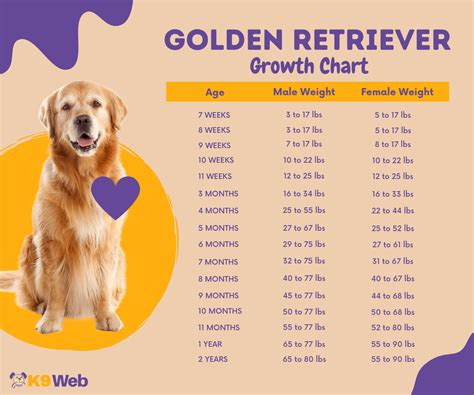Learn how to use a golden retriever weight chart in kg by age to keep your puppy growing on track and maintain a healthy weight into adulthood.
When I first brought home my golden retriever puppy Sunny, I was so excited to have this adorable bundle of fluff join our family. Little did I know how important it would be to keep a close eye on his weight as he grew.
The Importance of Tracking Your Golden's Growth
As a new dog owner, I learned that golden retrievers are prone to obesity if overfed. My vet emphasized that keeping Sunny at a healthy weight was crucial for preventing joint issues, diabetes, and other health problems retrievers can face. She advised me to monitor his body condition and weigh him regularly.
I'm glad I heeded her advice, because Sunny grew fast! Male golden retrievers like him typically reach their adult height by a year old but continue filling out until age 2. Following a golden retriever weight chart in kg by age helped me make sure Sunny stayed on track.

Golden Retriever Puppy Weight Chart in KG
| Age | Male Weight kg | Female Weight kg |
|---|---|---|
| Birth | 0.3 - 0.5 | 0.3 - 0.5 |
| 1 month | 2 - 4 | 1 - 3 |
| 2 months | 4 - 7 | 3 - 5 |
| 3 months | 7 - 10 | 5 - 8 |
| 4 months | 10 - 14 | 8 - 11 |
| 5 months | 14 - 18 | 11 - 15 |
| 6 months | 18 - 23 | 15 - 20 |
Source: Golden Retriever Club of America
I printed this chart out and taped it up in our kitchen. Each month on Sunny's birthday, we'd weigh him and check that he fell within the healthy range. It became a fun family event!
Healthy Adult Golden Retriever Weight
Once Sunny reached adulthood around 2 years old, his growth slowed. I learned that a healthy weight for a male is 29-34 kg, while females are a bit lighter at 25-29 kg. Of course, this varies a bit by frame size.
Sunny is a big boy with a large frame, so he falls on the upper end of the scale at a fit 34 kg. Our vet says he looks great and to keep up the good work with diet and exercise.
Some key things I've learned:
- Feed a high-quality dog food in controlled portions
- Limit treats to 10% of daily calories
- Provide plenty of exercise with walks, play, and swimming
- Have your vet assess body condition at annual check-ups
When to Be Concerned
If your golden is over- or underweight based on the chart, definitely talk to your vet. Sometimes an underlying health issue like hypothyroidism can be the cause.
In Sunny's case, he started looking a bit too rounded a few months after being neutered. Spaying/neutering increases the risk of weight gain. I had to cut his food back a bit and increase his exercise to get him back to ideal body condition. Catching gains early is key!
Conclusion
From cute puppy to handsome adult, tracking Sunny's growth has been a learning experience. Using a golden retriever weight kg chart by age has helped keep him fit and healthy into adulthood.
I'm grateful to the Golden Retriever Club of America for providing such a helpful resource for owners. With the right care, diet and monitoring, goldens can live well into their teen years. I hope Sunny will be by my side for many years to come!
